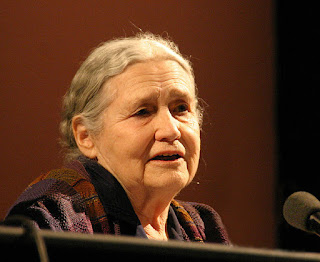What might be the most striking introspection in any book I've recently read is the way Doris Lessing in
The Memoirs of a Survivor makes her character withdraw so far inward that a rich, mysterious, and meditative space opens up and becomes as much a reality for the reader and the protagonist as the dystopic reality on the streets.
In
Memoirs, society has completely broken down, the few with money have left, and the rest of the population lives like squirrels in what's left of a big city, holed away in empty rooms and fearful of marauders and gangs looking for loot or to create clans to survive.
What is so striking is that Lessing never blows this up into melodramatic proportions--no zombies or futuristic, crazy technological controls or controllers--but rather she shows people trying to live as normally as possible, adapting, taking heart in the tiny securities and privacy left to them, while brooding insanity creeps just beyond the conscious borders of prolonged fear.
Because of her subtle craft, we can already imagine how easily our delicate society could unwind.
I sat waiting quietly in my living-room, knowing that she was asleep, exactly as one does with a small child. I did a little mending for her, washed and ironed her clothes. But mostly I sat and looked at that wall and waited. I could not help thinking that to have a child with me, just as the wall was beginning to open itself up, would be a nuisance , and in fact she and her animal were very much in the way (23-4).
Meditation and turning inward is not always easy, especially when forced to do it within the worsening climate on the physical plane. Lessing plumbs the psyche of her protagonist and dredges up the violence, the trauma that tucks itself away in the darkened crannies of our consciousness that most of us leave unexplored from birth to death.
It was about then I understood that the events on the pavements and what went on between me and Emily might have a connection with what I saw on my visits behind the wall.
Moving through the tall quiet white walls, as impermanent as theatre sets, knowing that the real inhabitant was there, always there just behind the next wall, to be glimpsed on the opening of the next door or the one beyond that, I came on a room--long, deep-ceilinged, once a beautiful room--which I recognised, which I knew (from where, though?), and it was in such disorder. I felt sick and was afraid. The place looked as if savages had been in it; as if soldiers had bivouacked there. The chairs and sofas had been deliberately slashed and jabbed with bayonets or knives, stuffing was spewing out everywhere, brocade curtains had been ripped off the brass rods and left in heaps. The room might have been used as a butcher's shop: there were feathers, blood, bits of offal. I began cleaning it. I laboured, used many buckets of hot water, scrubbed, mended. I opened tall windows to an eighteenth-century garden where plants grew in patters of squares among low hedges (40).
Behind the wall the other world calls our protagonist, and she explores the rooms, tidies them, and searches for the owner of the place. This is the one area she can control as the outside, real world spirals into further chaos and danger.
Lessing seems to be asking us, Is this the kind of catastrophe it takes to seek answers and inward
 |
| credit: Elke Wetzig (elya) |
healing? In a way, James Gould Cozzens shows us another side of this equation with his flabby protagonist securing as much material wealth as possible in
the peculiar, apocalyptic novel, Castaway.
But Lessing's is much more ambitious in terms of dystopian novels because it seriously examines the deteriorating relationships and imagines society in a way we normally don't.
Memoirs has been called "A visionary's extraordinary history of the future." Cozzens, equally entertaining and through-provoking, strikes a simpler chord by enclosing his character in the sprawling, empty shopping complex, leaving untouched the trickier aspects of maintaining an apocalyptic narrative.
The rapidly deteriorating situation seen out of our character's ground floor apartment window becomes even more frightening. Gangs of children camp on the street, light fires, and males stare down each other to gain prominence over the pack of stick-wielding kids. We worry for the child, Emily, and her pet beast, Hugo, as Emily wishes to join the kids.
Gerald, the leader of a large pack of wild kids, sets up an amazing system of collecting discarded goods from the old world, when society had order and structure, and to reassemble, or disassemble for their parts all the material goods that are no longer useful without electricity. What was for vanity, for desire, for want, becomes only important if it's needed to survive.
We sat on through the night quietly by our fire, waiting, listening.
There was nothing to prevent one or all of us becoming victims at any moment.
Nothing. Not the fact that Gerald, by himself or with a selection of the children, or even some of the children by themselves, might come down to visit us in the most normal way in the world. They brought us gifts. They brought flour and dried milk and eggs; sheets of polythene, cellotape, nails, tools of all kinds. They gave us fur rugs, coal, seeds, candles. They brought...the city around was almost empty, and all one had to do was to walk into unguarded buildings and warehouses and take what one fancied. But most of what was there were things no one would ever use again or want to: things about which, in a few years' time, if some survivor found them, he would have to ask, "What on earth could this have been for?"
As these children did already. You would see them squatting down over a pile of greeting cards, a pink nylon fluted lampshade, a polystyrene garden dwarf, a book, or a record, turning them over and over: What was this for? What did they do with it? (208).
How easy it is to float along into the internal rooms beyond the wall, yet as the reader who carries none of the risk or burden of the actual scenario outside in the crumbled city often craves to get back to the action, to the terror that awaits a small old woman living out her days quietly in an apartment that has no security--a door that can be broken in, a ground floor window that can be smashed, and no real protectors or truly trustworthy people.
Despite the kindness of Gerald's pack, there is no safety. Not even the illusion of safety.
But these visits, these gifts, did not mean that in another mood, on another occasion, they would not kill. And because of a whim, a fancy, an impulse (208).
That mysterious interior that Lessing opens up becomes a call for us, who still live in stable societies and have the luxury to do such inward exploring, to realize the impermanence of our superficial lifestyles and equip ourselves internally as much as materially.
As a narrative, what makes
Memoirs stand out is the spiritual and psychological layers that give a companionable depth to what would be, without that, another dystopian novel. The internal element allows us space to breathe, to think, to fear while lending a subtlety to the story that is missing in so many others.


